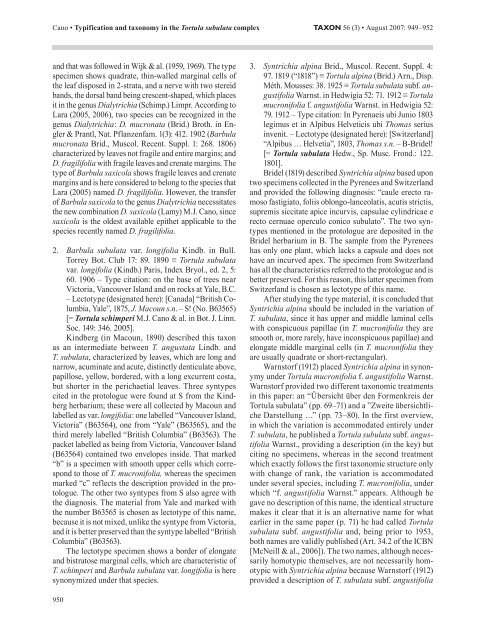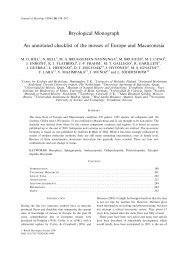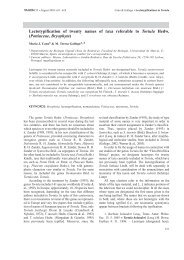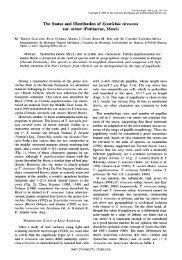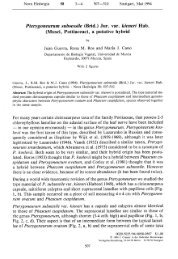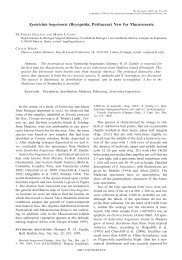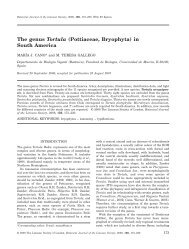Typification of the names of some infraspecific taxa in ... - Pottiaceae
Typification of the names of some infraspecific taxa in ... - Pottiaceae
Typification of the names of some infraspecific taxa in ... - Pottiaceae
Create successful ePaper yourself
Turn your PDF publications into a flip-book with our unique Google optimized e-Paper software.
Cano • <strong>Typification</strong> and taxonomy <strong>in</strong> <strong>the</strong> Tortula subulata complexTAXON 56 (3) • August 2007: 949–952and that was followed <strong>in</strong> Wijk & al. (1959, 1969). The typespecimen shows quadrate, th<strong>in</strong>-walled marg<strong>in</strong>al cells <strong>of</strong><strong>the</strong> leaf disposed <strong>in</strong> 2-strata, and a nerve with two stereidbands, <strong>the</strong> dorsal band be<strong>in</strong>g crescent-shaped, which placesit <strong>in</strong> <strong>the</strong> genus Dialytrichia (Schimp.) Limpr. Accord<strong>in</strong>g toLara (2005, 2006), two species can be recognized <strong>in</strong> <strong>the</strong>genus Dialytrichia : D. mucronata (Brid.) Broth. <strong>in</strong> Engler& Prantl, Nat. Pflanzenfam. 1(3): 412. 1902 (Barbulamucronata Brid., Muscol. Recent. Suppl. 1: 268. 1806)characterized by leaves not fragile and entire marg<strong>in</strong>s; andD. fragilifolia with fragile leaves and crenate marg<strong>in</strong>s. Thetype <strong>of</strong> Barbula saxicola shows fragile leaves and crenatemarg<strong>in</strong>s and is here considered to belong to <strong>the</strong> species thatLara (2005) named D. fragilifolia. However, <strong>the</strong> transfer<strong>of</strong> Barbula saxicola to <strong>the</strong> genus Dialytrichia necessitates<strong>the</strong> new comb<strong>in</strong>ation D. saxicola (Lamy) M.J. Cano, s<strong>in</strong>cesaxicola is <strong>the</strong> oldest available epi<strong>the</strong>t applicable to <strong>the</strong>species recently named D. fragilifolia.2. Barbula subulata var. longifolia K<strong>in</strong>db. <strong>in</strong> Bull.Torrey Bot. Club 17: 89. 1890 ≡ Tortula subulatavar. longifolia (K<strong>in</strong>db.) Paris, Index Bryol., ed. 2, 5:60. 1906 – Type citation: on <strong>the</strong> base <strong>of</strong> trees nearVictoria, Vancouver Island and on rocks at Yale, B.C.– Lectotype (designated here): [Canada] “British Columbia,Yale”, 1875, J. Macoun s.n. – S! (No. B63565)[= Tortula schimperi M.J. Cano & al. <strong>in</strong> Bot. J. L<strong>in</strong>n.Soc. 149: 346. 2005].K<strong>in</strong>dberg (<strong>in</strong> Macoun, 1890) described this taxonas an <strong>in</strong>termediate between T. angustata L<strong>in</strong>db. andT. subulata, characterized by leaves, which are long andnarrow, acum<strong>in</strong>ate and acute, dist<strong>in</strong>ctly denticulate above,papillose, yellow, bordered, with a long excurrent costa,but shorter <strong>in</strong> <strong>the</strong> perichaetial leaves. Three syntypescited <strong>in</strong> <strong>the</strong> protologue were found at S from <strong>the</strong> K<strong>in</strong>dbergherbarium; <strong>the</strong>se were all collected by Macoun andlabelled as var. longifolia : one labelled “Vancouver Island,Victoria” (B63564), one from “Yale” (B63565), and <strong>the</strong>third merely labelled “British Columbia” (B63563). Thepacket labelled as be<strong>in</strong>g from Victoria, Vancouver Island(B63564) conta<strong>in</strong>ed two envelopes <strong>in</strong>side. That marked“b” is a specimen with smooth upper cells which correspondto those <strong>of</strong> T. mucronifolia, whereas <strong>the</strong> specimenmarked “c” reflects <strong>the</strong> description provided <strong>in</strong> <strong>the</strong> protologue.The o<strong>the</strong>r two syntypes from S also agree with<strong>the</strong> diagnosis. The material from Yale and marked with<strong>the</strong> number B63565 is chosen as lectotype <strong>of</strong> this name,because it is not mixed, unlike <strong>the</strong> syntype from Victoria,and it is better preserved than <strong>the</strong> syntype labelled “BritishColumbia” (B63563).The lectotype specimen shows a border <strong>of</strong> elongateand bistratose marg<strong>in</strong>al cells, which are characteristic <strong>of</strong>T. schimperi and Barbula subulata var. longifolia is heresynonymized under that species.3. Syntrichia alp<strong>in</strong>a Brid., Muscol. Recent. Suppl. 4:97. 1819 (“1818”) ≡ Tortula alp<strong>in</strong>a (Brid.) Arn., Disp.Méth. Mousses: 38. 1925 ≡ Tortula subulata subf. angustifoliaWarnst. <strong>in</strong> Hedwigia 52: 71. 1912 ≡ Tortulamucronifolia f. angustifolia Warnst. <strong>in</strong> Hedwigia 52:79. 1912 – Type citation: In Pyrenaeis ubi Junio 1803legimus et <strong>in</strong> Alpibus Helveticis ubi Thomas serius<strong>in</strong>venit. – Lectotype (designated here): [Switzerland]“Alpibus … Helvetia”, 1803, Thomas s.n. – B-Bridel![= Tortula subulata Hedw., Sp. Musc. Frond.: 122.1801].Bridel (1819) described Syntrichia alp<strong>in</strong>a based upontwo specimens collected <strong>in</strong> <strong>the</strong> Pyrenees and Switzerlandand provided <strong>the</strong> follow<strong>in</strong>g diagnosis: “caule erecto ramos<strong>of</strong>astigiato, foliis oblongo-lanceolatis, acutis strictis,supremis siccitate apice <strong>in</strong>curvis, capsulae cyl<strong>in</strong>dricae erecto cernuae operculo conico subulato”. The two syntypesmentioned <strong>in</strong> <strong>the</strong> protologue are deposited <strong>in</strong> <strong>the</strong>Bridel herbarium <strong>in</strong> B. The sample from <strong>the</strong> Pyreneeshas only one plant, which lacks a capsule and does nothave an <strong>in</strong>curved apex. The specimen from Switzerlandhas all <strong>the</strong> characteristics referred to <strong>the</strong> protologue and isbetter preserved. For this reason, this latter specimen fromSwitzerland is chosen as lectotype <strong>of</strong> this name.After study<strong>in</strong>g <strong>the</strong> type material, it is concluded thatSyntrichia alp<strong>in</strong>a should be <strong>in</strong>cluded <strong>in</strong> <strong>the</strong> variation <strong>of</strong>T. subulata, s<strong>in</strong>ce it has upper and middle lam<strong>in</strong>al cellswith conspicuous papillae (<strong>in</strong> T. mucronifolia <strong>the</strong>y aresmooth or, more rarely, have <strong>in</strong>conspicuous papillae) andelongate middle marg<strong>in</strong>al cells (<strong>in</strong> T. mucronifolia <strong>the</strong>yare usually quadrate or short-rectangular).Warnstorf (1912) placed Syntrichia alp<strong>in</strong>a <strong>in</strong> synonymyunder Tortula mucronifolia f. angustifolia Warnst.Warnstorf provided two different taxonomic treatments<strong>in</strong> this paper: an “Übersicht über den Formenkreis derTortula subulata” (pp. 69–71) and a ”Zweite übersichtlicheDarstellung …” (pp. 73–80). In <strong>the</strong> first overview,<strong>in</strong> which <strong>the</strong> variation is accommodated entirely underT. subulata, he published a Tortula subulata subf. angustifoliaWarnst., provid<strong>in</strong>g a description (<strong>in</strong> <strong>the</strong> key) butcit<strong>in</strong>g no specimens, whereas <strong>in</strong> <strong>the</strong> second treatmentwhich exactly follows <strong>the</strong> first taxonomic structure onlywith change <strong>of</strong> rank, <strong>the</strong> variation is accommodatedunder several species, <strong>in</strong>clud<strong>in</strong>g T. mucronifolia, underwhich “f. angustifolia Warnst.” appears. Although hegave no description <strong>of</strong> this name, <strong>the</strong> identical structuremakes it clear that it is an alternative name for whatearlier <strong>in</strong> <strong>the</strong> same paper (p. 71) he had called Tortulasubulata subf. angustifolia and, be<strong>in</strong>g prior to 1953,both <strong>names</strong> are validly published (Art. 34.2 <strong>of</strong> <strong>the</strong> ICBN[McNeill & al., 2006]). The two <strong>names</strong>, although necessarilyhomotypic <strong>the</strong>mselves, are not necessarily homotypicwith Syntrichia alp<strong>in</strong>a because Warnstorf (1912)provided a description <strong>of</strong> T. subulata subf. angustifolia950


